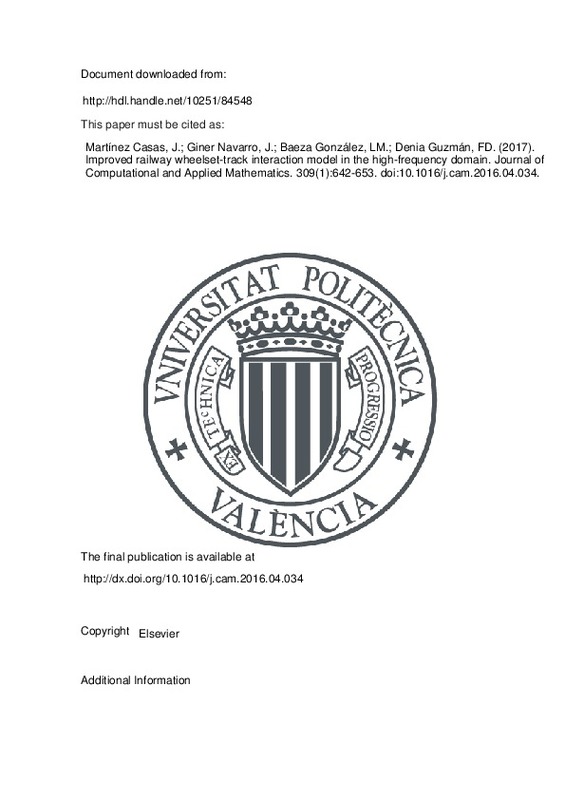JavaScript is disabled for your browser. Some features of this site may not work without it.
Buscar en RiuNet
Listar
Mi cuenta
Estadísticas
Ayuda RiuNet
Admin. UPV
Improved railway wheelset-track interaction model in the high-frequency domain
Mostrar el registro sencillo del ítem
Ficheros en el ítem
| dc.contributor.author | Martínez Casas, José
|
es_ES |
| dc.contributor.author | Giner Navarro, Juan
|
es_ES |
| dc.contributor.author | Baeza González, Luis Miguel
|
es_ES |
| dc.contributor.author | Denia Guzmán, Francisco David
|
es_ES |
| dc.date.accessioned | 2017-07-06T08:02:41Z | |
| dc.date.available | 2017-07-06T08:02:41Z | |
| dc.date.issued | 2017-01-01 | |
| dc.identifier.issn | 0377-0427 | |
| dc.identifier.uri | http://hdl.handle.net/10251/84548 | |
| dc.description.abstract | [EN] As it is well known, there are various phenomena related to railway train-track interaction, some of them caused by the high frequency dynamics of the system, such as rolling noise when the vehicle runs over the track, as well as squeal noise and short-pitch rail corrugation for curved tracks. Due to these phenomena and some others unsolved so far, a large effort has been made over the last 40 years in order to define suitable models to study the train-track interaction. The introduction of flexibility in wheelset and rail models was required to have a more realistic representation of the wheel-rail interaction effects at high frequencies. In recently published train-track interaction models, the rails are modelled by means of Timoshenko beam elements, valid up to 1.5 kHz for lateral rail vibration and up to 2 kHz for vertical vibration. This confines the frequency range of validity for the complete train-track model to 1.5 kHz. With the purpose of extending the range of validity above 1.5 kHz, a 3D track model based on the Moving Element Method (MEM) is developed in this paper to replace the Timoshenko beam considered in earlier studies, adopting cyclic boundary conditions and Eulerian coordinates. The MEM approach considers a mobile Finite Element (FE) mesh which moves with the vehicle, so the mass of the rail flows with the vehicle speed but in the opposite direction through the mesh. Therefore, the MEM permits to fix the contact area in the middle of a finitely long track and to refine the mesh only around the contact area, where the forces and displacements will be more significant. Additionally, a modal approach is adopted in order to reduce the number of degrees of freedom of the rail model. Both strategies lower substantially the computational cost. Simulation results are presented and discussed for different excitation sources including random rail roughness and singularities such as wheel flats. All the simulation cases are carried out for a Timoshenko beam and a 3D MEM track model in order to point out the differences in the contact forces above the range of validity of the Timoshenko beam. | es_ES |
| dc.description.sponsorship | The authors gratefully acknowledge the financial support of Ministerio de Economía y Competitividad and the European Regional Development Fund (project TRA2013-45596-C2-1-R), as well as Generalitat Valenciana (project Prometeo/2012/023) and Ministerio de Educación, Cultura y Deporte (project SP20140659) as part of Programa Campus de Excelencia Internacional. | |
| dc.language | Inglés | es_ES |
| dc.publisher | Elsevier | es_ES |
| dc.relation.ispartof | Journal of Computational and Applied Mathematics | es_ES |
| dc.rights | Reserva de todos los derechos | es_ES |
| dc.subject | Flexible wheelset | es_ES |
| dc.subject | Flexible track | es_ES |
| dc.subject | Moving element method | es_ES |
| dc.subject | Train-track interaction | es_ES |
| dc.subject | High frequency dynamics | es_ES |
| dc.subject.classification | INGENIERIA MECANICA | es_ES |
| dc.subject.classification | CIENCIA DE LOS MATERIALES E INGENIERIA METALURGICA | es_ES |
| dc.title | Improved railway wheelset-track interaction model in the high-frequency domain | es_ES |
| dc.type | Artículo | es_ES |
| dc.type | Comunicación en congreso | |
| dc.identifier.doi | 10.1016/j.cam.2016.04.034 | |
| dc.relation.projectID | info:eu-repo/grantAgreement/MINECO//TRA2013-45596-C2-1-R/ES/DESARROLLO DE NUEVAS TECNOLOGIAS DESTINADAS A REDUCIR EL IMPACTO ACUSTICO DEL TRANSPORTE FERROVIARIO EN ENTORNOS URBANOS/ | es_ES |
| dc.relation.projectID | info:eu-repo/grantAgreement/GVA//PROMETEO%2F2012%2F023/ES/MODELADO NUMERICO AVANZADO EN INGENIERIA MECANICA/ | es_ES |
| dc.relation.projectID | info:eu-repo/grantAgreement/MECD//SP20140659/ | es_ES |
| dc.rights.accessRights | Abierto | es_ES |
| dc.contributor.affiliation | Universitat Politècnica de València. Escuela Técnica Superior de Ingenieros Industriales - Escola Tècnica Superior d'Enginyers Industrials | es_ES |
| dc.contributor.affiliation | Universitat Politècnica de València. Escuela Técnica Superior de Ingeniería del Diseño - Escola Tècnica Superior d'Enginyeria del Disseny | es_ES |
| dc.description.bibliographicCitation | Martínez Casas, J.; Giner Navarro, J.; Baeza González, LM.; Denia Guzmán, FD. (2017). Improved railway wheelset-track interaction model in the high-frequency domain. Journal of Computational and Applied Mathematics. 309(1):642-653. https://doi.org/10.1016/j.cam.2016.04.034 | es_ES |
| dc.description.accrualMethod | S | es_ES |
| dc.relation.conferencename | International Conference on Mathematical Modeling in Engineering and Human Behavior | |
| dc.relation.conferencedate | September 09-11, 2015 | |
| dc.relation.conferenceplace | Valencia, Spain | |
| dc.relation.publisherversion | http://dx.doi.org/10.1016/j.cam.2016.04.034 | es_ES |
| dc.description.upvformatpinicio | 642 | es_ES |
| dc.description.upvformatpfin | 653 | es_ES |
| dc.type.version | info:eu-repo/semantics/publishedVersion | es_ES |
| dc.description.volume | 309 | es_ES |
| dc.description.issue | 1 | es_ES |
| dc.relation.senia | 312335 | es_ES |
| dc.contributor.funder | Ministerio de Economía y Competitividad | |
| dc.contributor.funder | Ministerio de Educación, Cultura y Deporte | |
| dc.contributor.funder | Generalitat Valenciana |







![[Cerrado]](/themes/UPV/images/candado.png)

